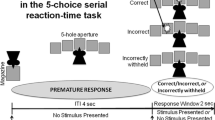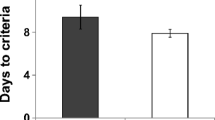Abstract
Rationale
The 5-choice serial reaction time task (5-CSRTT) is commonly used to assess attention in rodents. Manipulation of this task by decreasing the light stimulus duration is often used to probe attentional capacity and causes a decrease in accuracy and an increase in omissions. However, although a decrease in response accuracy is commonly interpreted as a decrease in attention, it is more difficult to interpret an increase in omissions in terms of attentional performance.
Methods
Here we present a series of experiments in rats that seeks to investigate the origins of these key behavioral measures of attention in the 5-CSRTT. After an initial training in the 5-CSRTT, rats were tested in a variable stimulus duration procedure to increase task difficulty and probe visual attentional capacity under several specific controlled conditions.
Conclusions
We found that response accuracy reflects visuospatial sustained attentional processing, as commonly interpreted, while response omission reflects rats’ ignorance about the stimulus location, presumably due to failure to pay attention to the curved wall during its presentation. Moreover, when rats lack of relevant information, they choose not to respond instead of responding randomly. Finally, pretreatment with nicotine selectively decreased response omissions, without affecting response accuracy, particularly when the attentional demand was high. Overall, our results indicate that response accuracy and response omission thus correspond to two distinct attentional states.






Similar content being viewed by others
References
Acosta-Lopez JE, Suarez I, Pineda DA, Cervantes-Henriquez ML, Martinez-Banfi ML, Lozano-Gutierrez SG et al (2021) Impulsive and omission errors: potential temporal Processing endophenotypes in ADHD. Brain Sci 11:9
Amitai N, Markou A (2011) Comparative effects of different test day challenges on performance in the 5-choice serial reaction time task. Behav Neurosci 125(5):764–774
Arnsten AF (2006) Fundamentals of attention-deficit/hyperactivity disorder: circuits and pathways. J Clin Psychiatry 67(Suppl 8):7–12
Asinof SK, Paine TA (2014) The 5-choice serial reaction time task: a task of attention and impulse control for rodents. J Vis Exp (90):e51574
Bari A, Dalley JW, Robbins TW (2008) The application of the 5-choice serial reaction time task for the assessment of visual attentional processes and impulse control in rats. Nat Protoc 3(5):759–767
Conners CK, Epstein JN, Angold A, Klaric J (2003) Continuous performance test performance in a normative epidemiological sample. J Abnorm Child Psychol 31(5):555–562
Cornblatt BA, Malhotra AK (2001) Impaired attention as an endophenotype for molecular genetic studies of schizophrenia. Am J Med Genet 105(1):11–15
Dalley JW, Theobald DE, Berry D, Milstein JA, Laane K, Everitt BJ et al (2005) Cognitive sequelae of intravenous amphetamine self-administration in rats: evidence for selective effects on attentional performance. Neuropsychopharmacology 30(3):525–537
Fetsch CR, Kiani R, Shadlen MN (2014) Predicting the accuracy of a decision: a neural mechanism of confidence. Cold Spring Harb Symp Quant Biol 79:185–197
Gold JI, Shadlen MN (2007) The neural basis of decision making. Annu Rev Neurosci 30:535–574
Gould TJ (2010) Addiction and cognition. Addict Sci Clin Pract 5(2):4–14
Hahn B, Shoaib M, Stolerman IP (2002) Nicotine-induced enhancement of attention in the five-choice serial reaction time task: the influence of task demands. Psychopharmacology 162(2):129–137
Hervig ME, Toschi C, Petersen A, Vangkilde S, Gether U, Robbins TW (2023) Theory of visual attention (TVA) applied to rats performing the 5-choice serial reaction time task: differential effects of dopaminergic and noradrenergic manipulations. Psychopharmacology 240(1):41–58
Kiani R, Corthell L, Shadlen MN (2014) Choice certainty is informed by both evidence and decision time. Neuron 84(6):1329–1342
Lo CC, Wang XJ (2006) Cortico-basal ganglia circuit mechanism for a decision threshold in reaction time tasks. Nat Neurosci 9(7):956–963
Mirza NR, Stolerman IP (1998) Nicotine enhances sustained attention in the rat under specific task conditions. Psychopharmacology 138(3–4):266–274
Ornstein TJ, Iddon JL, Baldacchino AM, Sahakian BJ, London M, Everitt BJ et al (2000) Profiles of cognitive dysfunction in chronic amphetamine and heroin abusers. Neuropsychopharmacology 23(2):113–126
Robbins TW (2002) The 5-choice serial reaction time task: behavioural pharmacology and functional neurochemistry. Psychopharmacology 163(3–4):362–380
Smith PL, Ratcliff R (2004) Psychology and neurobiology of simple decisions. Trends Neurosci 27(3):161–168
Stolerman IP, Mirza NR, Hahn B, Shoaib M (2000) Nicotine in an animal model of attention. Eur J Pharmacol 393(1–3):147–154
Turner KM, Peak J, Burne TH (2015) Measuring attention in rodents: comparison of a Modified Signal Detection Task and the 5-Choice serial reaction Time Task. Front Behav Neurosci 9:370
Acknowledgements
This work was supported by the French Research Council (CNRS), the Université de Bordeaux, and the French National Agency (ANR- 15-CE37-0008-01; K.G.).
Author information
Authors and Affiliations
Contributions
K.G. and S.H.A designed research and experiments; C.V.M, A.D. and K.G. performed behavioral experiments and associated data analysis; K.G. and S.H.A. wrote the paper.
Corresponding author
Ethics declarations
The authors have nothing to disclose.
Competing interests
The authors report no conflict of interest.
Additional information
Publisher’s Note
Springer Nature remains neutral with regard to jurisdictional claims in published maps and institutional affiliations.
Rights and permissions
Springer Nature or its licensor (e.g. a society or other partner) holds exclusive rights to this article under a publishing agreement with the author(s) or other rightsholder(s); author self-archiving of the accepted manuscript version of this article is solely governed by the terms of such publishing agreement and applicable law.
About this article
Cite this article
Vouillac-Mendoza, C., Durand, A., Ahmed, S.H. et al. Knowledge by omission: the significance of omissions in the 5-choice serial reaction time task. Psychopharmacology (2024). https://doi.org/10.1007/s00213-024-06564-2
Received:
Accepted:
Published:
DOI: https://doi.org/10.1007/s00213-024-06564-2




